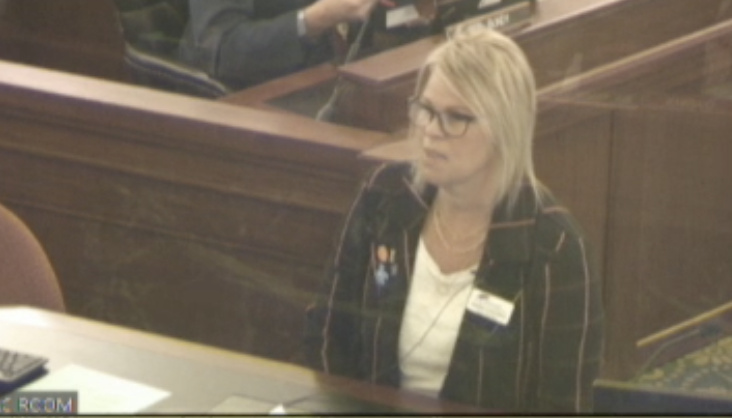Amidst budget cuts and staff furloughs, the University of Idaho and the state’s sister institutions delivered on a top priority this fall. The university stayed open for in-state instruction.
“We did the hard work, and we succeeded,” President C. Scott Green told legislative budget-writers Monday morning.
Green kicked off “Education Week” at the Statehouse Monday, including a series of budget presentations before the Legislature’s Joint Finance-Appropriations Committee. Not surprisingly, the coronavirus pandemic was a central talking point. And Monday’s hearing even had a pandemic feel: Green addressed lawmakers remotely, from a state Division of Financial Management conference room across the street from the Statehouse, while Idaho’s other college and universities spoke remotely from their respective campuses.
In the 10 months since Idaho reported its first confirmed coronavirus case — forcing all of the state’s public colleges and universities to go online for spring semester — the pandemic has had a dramatic effect on university operations:
- The U of I lost about $7 million due to the spring closure, writing off revenues from student room-and-board and campus events. Launching a campus coronavirus testing lab and preparing the campus for a fall reopening cost more than $1 million, Green said.
- Despite reopening for face-to-face instruction last fall, full-time, on-campus enrollment dropped by 3 percent. University officials had braced for a steeper decline, and Green said the 3 percent decrease is “manageable.” But before the pandemic, the U of I was on track for an enrollment boom, with applications up for 16 percent and admissions up by 14 percent.
- Green touted the U of I’s graduation rate, which is highest in the state and close to the national average. The six-year graduation rate is 59 percent. However, he said, the pandemic will make it tougher to keep students on campus and on pace toward a degree.
Green touted the university’s fiscal turnaround, an effort that predated the pandemic. Over three years, the university cut $45 million in spending and eliminated 160 positions, many permanently. Consequently, he said, the university is now operating with a $900,000 surplus.
This week, JFAC will hear budget presentations from the state’s other college and university presidents. In February, lawmakers will start writing a higher education budget for 2021-22. Gov. Brad Little has proposed putting $315.2 million of general fund tax dollars into the state’s four-year colleges and universities, an $8.2 million increase.
Green, Boise State University President Marlene Tromp and Idaho State University President Kevin Satterlee have pledged to freeze tuition for a second consecutive year, if lawmakers approve Little’s request.
Satterlee: ‘We answered the call’
Trying to get out ahead of another potential fight over Little’s budget proposal, Satterlee said the state’s college and university presidents have heard legislators loud and clear.
After the 2020 session, he said, the institutions looked at their organizational charts, position by position, cutting 493 jobs. They also found $77 million in savings and imposed $11 million in employee furloughs.
“We answered the call, and we did what we had to do,” said Satterlee, making joint remarks on behalf of the presidents Monday morning. “It was what the state asked us to.”
With the remaining dollars, Satterlee said, the colleges and universities are focusing on core missions: enrollment and retention, connecting with rural communities, research and producing graduates with practical job skills.
Under questioning from Rep. Wendy Horman, R-Idaho Falls, Satterlee pushed for one piece of Little’s higher education request: $13.5 million to offset coronavirus-related revenue losses. That money would come from a state savings account that is, in turn, filled from interest on student tuition payments. “It is intended for just this kind of rainy day,” Satterlee said.
If 2020 is any indication, the higher ed budget figures to get tight scrutiny this session. A year ago, House conservatives killed two higher ed spending bills before a third version finally passed.
Critchfield: Ten months of challenges and opportunities
Kicking off Education Week, State Board of Education President Debbie Critchfield said the pandemic forced education leaders to make progress on some long-standing goals.
“We were presented with some challenges along with some opportunities,” Critchfield told JFAC.

One example is Online Idaho, a marketplace that will help rural residents take college and university courses remotely. State leaders have talked about this idea for years, since then-Gov. Butch Otter’s 2017 higher education task force. The state used $4 million of federal coronavirus stimulus dollars to ramp up the project.
Stimulus dollars also helped jumpstart other projects. Idaho used $30 million to narrow the digital divide in K-12 classrooms — although the state still needs another 30,000 or so computers to provide every student with a device. The $50 million Strong Families, Strong Students program provided grants to more than 18,000 families, designed to offset the costs of online learning.
But as Green would say later Monday, Critchfield said the State Board’s top priority has been to keep schools open, from K-12 through college. “That has been the goal, and we backed everything up from that,” she said.
Idaho Education News covered Monday’s hearings remotely.
